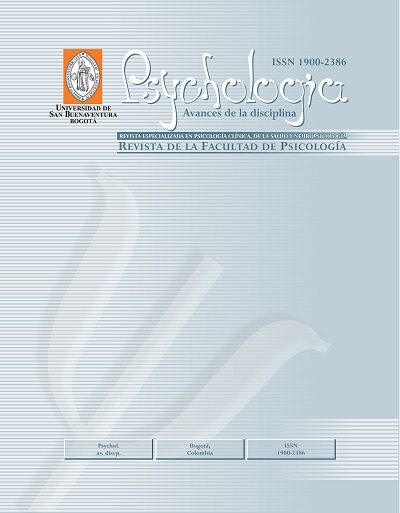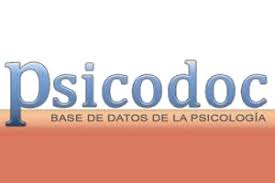Esta revista proporciona un acceso abierto inmediato a su contenido, basado en el principio de que ofrecer al público un acceso libre a las investigaciones ayuda a un mayor intercambio global de conocimiento.
Por tanto se acoge a la Licencia Creative Commons 4.0 Atribuciones Reconocimiento – NoComercial – CompartirIgual (by-nc-sa): No se permite un uso comercial de la obra original ni de las posibles obras derivadas, la distribución de las cuales se debe hacer con una licencia igual a la que regula la obra original.
http://creativecommons.org/licenses/by-nc-sa/4.0/
Resumen
En este artículo se presentan dos índices alternativos para la evaluación e interpretación de las habilidades cristalizadas a partir del WISC-IV versión argentina: el índice conocimiento léxico (Gc-VL) y el índice información general
(Gc-K0). Para ello se trabajó con una muestra de 1036 casos. El análisis factorial confirmatorio revela altos índices que validan las nuevas puntuaciones. El análisis de fiabilidad resultó satisfactorio. A su vez, los resultados revelan correlaciones entre el índice comprensión verbal (ICV) del WISC-IV y los nuevos índices alternativos. Por último, se encontraron diferencias en las puntuaciones Gc-VL y Gc-K0 y el clima educativo del hogar. Si bien el WISC-IV propone cuatro índices compuestos y una medida global de la inteligencia (ICV, IRP, IMO, IVP y CIT), siguiendo los aportes de la teoría de Cattell-Horn-Carroll (CHC), se recomienda implementar estas puntuaciones alternativas en un contexto normativo e ipsativo, que favorezcan y enriquezcan el estudio de las capacidades cristalizadas del examinado.
Palabras clave:
Referencias
Arán Filippetti, V. (2012). Estrato socioeconómico y habilidades cognitivas en niños escolarizados: variables predictoras y mediadoras. Psykhe (Santiago), 21 (1). 3-30. DOI: doi.org/10.4067/S0718-22282012000100001
Bates, T., Hansell, N., Martinb, N. & Wright, M. (2016).When does socioeconomic status (SES) moderate the heritability of IQ? No evidence for g × SES interaction for IQ in a representative sample of 1176 Australian adolescent twin pairs. Intelligence, 56 (10-15). DOI: doi.org/10.1016/j.intell.2016.02.003
Brenlla, M. E. (2013). Interpretación del WISC-IV: puntuaciones compuestas y modelos CHC. Ciencias Psicológicas, 7 (2). 183-197. DOI: doi.org/10.22235/cp.v7i1
Carroll, J. B. (1993). Human cognitive abilities: A survey of factor-analytic studies. Cambridge: Cambridge University Press.
Cattell, R. B. (1963). Theory of fluid and crystallized intelligence: A critical experiment. Journal of Educational Psychology, 54 (1). 1-22. DOI: http://dx.doi.org/10.1037/h0046743
Cerqueiro, F.F. (2013). Actividades lúdicas de repaso y su función motivadora en lenguas para fines específicos. Encuentro 22, 38-52. Recuperado de: http://encuentrojournal.org/textcit.php?textdisplay=456
Flanagan, D. P. & Kaufman, A. (2006). Claves para la evaluación con el WISC-IV. Madrid: TEA Ediciones.
Flanagan, D. P., & McGrew, K. S. (1997). A cross-battery approach to assessing and interpreting cognitive abilities: Narrowing the gap between practice and cognitive science. En D. P. Flanagan, J. L. Genshaft, & P. L. Harrison (Eds.), Contemporary intellectual assessment: Theories, tests, and issues (pp. 314–325). Nueva York: Guilford Press.
Flanagan, D. P., & Dixon, S. G. (2013). The Cattell–Horn–Carroll Theory of cognitive abilities. En C. R. Reynolds, K. J. Vannest, & E. Fletcher-Janzen (Eds.), Encyclopedia of Special Education (pp. 368–382). Hoboken, NJ: John Wiley & Sons.
Flanagan, D. P., McGrew, K. S. & Ortiz, S. (2000). The Wechsler Intelligence Scales and Gf-Gc Theory: A Contemporary Approach to Interpretation. Estados Unidos: Allyn & Bacon
Grégoire, J. (2009). L'examen clinique de l'intelligence de l'enfant: Fondements et pratique du WISC-IV (2º Ed.). Sprimont: Mardaga.
Horn, J. L. & Noll, J. (1997). Human cognitive capabilities: Gf-Gc theory. En D. P. Flanagan, J. L. Gensaft, & P. L. Harrison (Eds.). Contemporary intellectual assessment: Theories, tests, and issues (pp. 53-91). Nueva York: Guilford Press.
Horn, J. L. (1991). Measurement of intellectual capabilities: A review of theory. En K. S. McGrew, J. K. Werder & R. W. Woodcock (Eds.), Woodcock-Johnson technical manual (pp. 197-232). Itasca, IL: Riverside.
Hunt, E. B. (2000). Let's hear it for crystallized intelligence. Learning and Individual Differences, 12 (1), 123–130.
Keith, T. Z. & Reynolds, M. R. (2010). Cattell–Horn–Carroll abilities and cognitive tests: what we´ve learned from 20 years of research. Psychology in the Schools, 47 (7). 635 – 650. DOI: 10.1002/pits.20496
Keith, T. Z., Fine, J.G., Taub, G., Reynolds, M.R., & Kranzler, J.H. (2006). Higher Order, Multisample, Confirmatory Factor Analysis of the Weschler Intelligence Scale for Children-Fourth Edition: What does It Measure? School Psychology Review, 35 (1), 108 - 127. Recuperado de: https://scholars.opb.msu.edu/en/publications/higher-order-multisample-confirmatory-factor-analysis-of-the-wech-3
Mascolo, J. T., Flanagan, D. P. & Alfonso, V. C. (2014). Essentials of Planning, Selecting, and Tailoring Interventions for Unique Learners (Essentials of Psychological Assessment). Nueva York: Guilford Press.
McGrew. K.S. (2009). CHC theory and the human cognitive abilities project: Standing on the shoulders of the giants of psychometric intelligence research. Intelligence 37 (1). 1 – 10. DOI: 10.1016/j.intell.2008.08.004
Muñoz-Sandoval, A. F., Woodcock, R. W., McGrew, K. S., & Mather, N. (2005). Batería III Woodcock-Muñoz. Itasca, IL: Riverside Publishing.
Plucker, J. A., Esping, A., Kaufman, J.C. & Avitia, M.J. (2015). Creativity and Intelligence. En S. Goldstein, D. Princiotta & J. Naglieri, (Eds.), Handbook of Intelligence: Evolutionary Theory, Historical Perspective, and Current Concepts. (pp. 283-291). Nueva York: Springer.
Reynolds, M.R. & Turek, J.J. (2012). A dynamic developmental link between verbal comprehension-knowledge (Gc) and reading comprehension: Verbal comprehension knowledge drives positive change in reading comprehension. Journal of School Psychology, 50 (841–863). DOI: 10.1016/j.jsp.2012.07.002
Rosemberg, C. & Stein, A. (2015). Guía 2: juegos con palabras y conceptos para promover el aprendizaje del vocabulario. Ciudad Autónoma de Buenos Aires: Organización de Estados Iberoamericanos para la Educación, la Ciencia y la Cultura. Alfabetización temprana en el Nivel Inicial. Recuperado de: https://www.unicef.org/argentina/spanish/EDUCACION_Guia_2_ALFABETIZACION.pdf
Schneider, W. J., & McGrew, K. S. (2012). The Cattell-Horn-Carroll model of intelligence. En D. Flanagan & P. Harrison (Eds.), Contemporary intellectual assessment: Theories, tests, and issues (3º Ed.) Nueva York: Guilford Press.
Schroeders, U., Schipolowski, S., Zettler, I., Golle, J., & Wilhelm, O. (2016). Do the smart get smarter? Development of fluid and crystallized intelligence in 3rd grade. Intelligence (Kidlington), 59. 84-95. DOI: 10.1016/j.intell.2016.08.003
Spearman, C. E. (1946). Theory of general factor. British Journal of Psychology, 36 (3). 117-131. DOI: 10.1111/j.2044-8295.1946.tb01114.x
Taborda, A., Barbenza, C. & Brenlla, M.E. (2011). Adaptación argentina del WISC-IV Wechsler. Escala de Inteligencia de Wechsler para niños cuarta edición (WISC-IV). Buenos Aires: Paidós.
Tacke, N., Bailey, L. & Clearfield, M. (2015). Socio-economic Status (SES) Affects Infants’ Selective Exploration. Infant and Child Development, 35 (1), 29-35. DOI: 10.1002/icd.1900
Tellegen, A., & Briggs, P. (1967). Old wine in new skins: Grouping Wechsler subtests into new scales. Journal of Consulting Psychology, 31 (5), 499-506. DOI: http://dx.doi.org/10.1037/h0024963
Zaval, L., Li, Y., Johnson, E. & Weber, E. (2015). Complementary Contributions of Fluid and Crystallized Intelligence to Decision Making Across the Life Span. En T.M Hess, C. J. Strough & C.E. Lockenhoff (Eds.), Aging and Decision-Making: Empirical and Applied Perspectives. (pp. 149-168). San Diego, CA: Elsevier Academic Press.





















